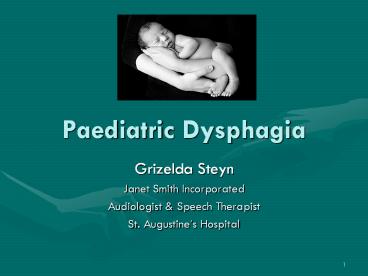Paediatric Dysphagia - PowerPoint PPT Presentation
1 / 15
Title:
Paediatric Dysphagia
Description:
Paediatric Dysphagia Grizelda Steyn Janet Smith Incorporated Audiologist & Speech Therapist St. Augustine s Hospital Background of Dysphagia Feeding problems common ... – PowerPoint PPT presentation
Number of Views:397
Avg rating:3.0/5.0
Title: Paediatric Dysphagia
1
Paediatric Dysphagia
- Grizelda Steyn
- Janet Smith Incorporated
- Audiologist Speech Therapist
- St. Augustines Hospital
2
Background of Dysphagia
- Feeding problems common in NICU/preterm infants
- Minor feeding problems in normal children 25-30
- 40-70 feeding problems in premature infants and
infants with chronic illness - Feeding is very complex process which involve
mouth, pharynx, larynx and esophagus and sucking
reflex in infants in the first phase. - Cornerstones of infant feeding
suck/swallow/breath - Sucking reflex initiates swallowing in the infant
by stimulation of the lips and deeper parts of
the oral cavity. - The mandible, maxilla, upper gums, lips, palate
and cheeks are necessary for compression of the
nipple and expression of contents
3
General Background
- Any defect of lips, tongue, palate, mandible,
maxilla or cheeks may create problems in the
first phase of feeding in an infant. - 3 stages of swallowing disorders oral
phase,pharyngeal phase and esopharyngeal phase)
4
What is Dysphagia?
- Difficulty swallowing
- The inability of food or liquids to pass easily
from the mouth, into the throat, and down into
the esophagus to the stomach during the process
of swallowing.
5
What could affect successful feeding in an infant?
- Conditions that impact the neurological system
developing, respiration and digestion. - Medications often have side effects that could
cause nausea, stomach pain and irritation. - Cardiac patients often lack the endurance to take
sufficient amount of liquid in a timely manner.
6
What about our Premature/NICU infants?
- Difficult delivery
- Aspiration, hypoxia
- Impacts postural control, breathing regulation,
state of infant, oral and pharyngeal reflexes - Prolonged ventilation
- Cardiac problems
- Start with limited respiratory reserves
- Difficulty regulating cardio-respiratory function
- Impacts energy, endurance, intake, coordination
and safety
7
Premature/NICU infants
- Congenital anomalies
- Cleft lip- and palate
- Hyperbilirubinemia (Jaundice)
- Impacts alertness, vigor and therefore intake.
- Infant of Diabetic motor( IDM)
- Impact work of breathing and therefore disrupts
coordination of suck-swallow-breathe sequence. - Respiratory Distress Syndrome (RDS)
- Compromise the transition to nipple feeding
8
Common feeding difficulties in NICU
- Tires before finishing feeding
- Lacks spontaneous mouth opening breathing too
much effort to be willing to suck. - Feeding for long periods at a time
- Difficulty coordinating sucking, breathing and
swallowing - Gagging during feeding
- Drooling
- Congestion in the chest after drinking
- Coughing or choking when drinking (or very soon
afterwards)
9
Symptoms of Dysphagia
- Tiredness or shortness of breath while eating or
drinking - Frequent respiratory infections
- Colour change during feeding, such as becoming
blue or pale silent aspiration - Spitting up or vomiting frequently
- Food or liquids coming out of the nose during or
after a feeding - Disorganized sucking overall postural
disorganization and poor sucking rhythm, poor
tongue stability - Trouble latching related to breathing, abnormal
CNS or could be oral-tactile hypersensitivity - Weight loss
10
Important to remember
- The reluctance to suck may be an instinctive
reaction, a purposeful respond to attempt to
protect their airway.
11
Protocol for Oral feeding
- 34 weeks G.A
- Weight of 1.6kg
- No medical conditions that would interfere with
feeding - Respiratory rate 70 breaths per minute
- Effort no change in skin colour
- Able to maintain a wakeful state of 10-15 minutes
- Aspiration none (Swallowing of Oral Secretions?)
- Ability to gag and reflexively protect airway.
- Rhythmic, non-nutritive sucking
12
Treatment of Dysphagia
- Goal of treatment plan is safe, independent
feeding(swallow). - Changing bottle or teats Premature infant
bigger teat provide internal stability. (Tongue
position and mouth size). - Positioning impacts airway maintenance,
breathing, safe swallow and organization of
infant - Swaddling provides overall postural support and
containment - Pacing of feeds
- Flow rate greatest obstacle to safe and
successful feeding. Increased flow poor
endurance/weak suck. Reduce flow- poor
coordination of SSB. Aspiration!!
13
Treatment of Dysphagia
- Oral motor Swallowing simulation techniques
- Pacifiers
- Calorically dense formulas (Cardiopulmonary
disorders) - NGT
- PEG
14
Outcome of our babies in NICU
- Early intervention
- Good prognosis for babies with no severe or
chronic illness - Maturation of CNS
- Alternative feeding as part of goal towards
successful feeding
15
Questions or Comments?































